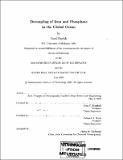| dc.contributor.advisor | John C. Marshall and Edward A. Boyle. | en_US |
| dc.contributor.author | Parekh, Payal | en_US |
| dc.contributor.other | Woods Hole Oceanographic Institution. | en_US |
| dc.date.accessioned | 2010-10-22T19:52:12Z | |
| dc.date.available | 2010-10-22T19:52:12Z | |
| dc.date.copyright | 2003 | en_US |
| dc.date.issued | 2003 | en_US |
| dc.identifier.uri | http://hdl.handle.net/1721.1/59512 | |
| dc.description | Thesis (Ph. D.)--Joint Program in Oceanography/Applied Ocean Science and Engineering (Massachusetts Institute of Technology, Dept. of Earth, Atmospheric, and Planetary Sciences, and the Woods Hole Oceanographic Institution), 2003. | en_US |
| dc.description | Includes bibliographical references (p. 132-139). | en_US |
| dc.description.abstract | Iron (Fe) is an essential micronutrient for marine phytoplankton often limiting phytoplankton growth due to its low concentration in the ocean and thus playing a role in modulating the ocean's biological pump. In order to understand controls on global Fe distribution, the decoupling between Fe and P04 and the sensitivity of surface nutrient concentrations to changes in aeolian iron supply, I use a hierarchy of ocean circulation and biogeochemistry models. I formulate a mechanistic model of iron cycling which includes scavenging onto sinking particles and complexation with an organic ligand. The iron cycle is coupled to a model of the phosphorus cycle. The aeolian source of iron is prescribed. This system is examined in the context of a highly idealized box model. With appropriate choice of parameter values, the model can be brought into consistency with the relatively sparse ocean observations of iron in the oceans. I implement this biogeochemical scheme in a coarse resolution ocean general circulation model, guided by the box model sensitivity studies. This model is also able to reproduce the broad regional patterns of iron and phosphorus. In particular, the high macro-nutrient concentrations of the Southern Oceans result from iron limitation in the model. I define a tracer, Fe* that quantifies the degree to which a water mass is iron limited. Surface waters in high nutrient, low chlorophyll regions have negative Fe* values, indicating Fe limitation, because aeolian surface dust flux is not sufficient to | en_US |
| dc.description.abstract | (cont.) compensate for the lack of iron in upwelled waters. The oceanic residence time of Fe is [approximately] 285 years in the model, confirming that transport plays an important role in controlling deep water [Fe[Tau]]. Globally, upwelling accounts for 40% of 'new' iron reaching the euphotic zone. Due to the potential ability of iron to change the efficiency of the carbon pump in the remote Southern Ocean, I study Southern Ocean surface P04 response to increased aeolian dust flux. My box model results suggest that a global ten fold increase in dust flux can support a P04 drawdown of [approximately]0.25[mu]M, while the GCM results suggest a P04 drawdown of 0.5 [mu]M. | en_US |
| dc.description.statementofresponsibility | by Payal Parekh. | en_US |
| dc.format.extent | 139 p. | en_US |
| dc.language.iso | eng | en_US |
| dc.publisher | Massachusetts Institute of Technology | en_US |
| dc.rights | M.I.T. theses are protected by
copyright. They may be viewed from this source for any purpose, but
reproduction or distribution in any format is prohibited without written
permission. See provided URL for inquiries about permission. | en_US |
| dc.rights.uri | http://dspace.mit.edu/handle/1721.1/7582 | en_US |
| dc.subject | Earth, Atmospheric, and Planetary Sciences. | en_US |
| dc.subject | Joint Program in Oceanography/Applied Ocean Science and Engineering. | en_US |
| dc.subject | Woods Hole Oceanographic Institution. | en_US |
| dc.title | Decoupling of iron and phosphate in the global ocean | en_US |
| dc.type | Thesis | en_US |
| dc.description.degree | Ph.D. | en_US |
| dc.contributor.department | Joint Program in Oceanography/Applied Ocean Science and Engineering | en_US |
| dc.contributor.department | Woods Hole Oceanographic Institution | en_US |
| dc.contributor.department | Massachusetts Institute of Technology. Department of Earth, Atmospheric, and Planetary Sciences | |
| dc.identifier.oclc | 54665242 | en_US |
